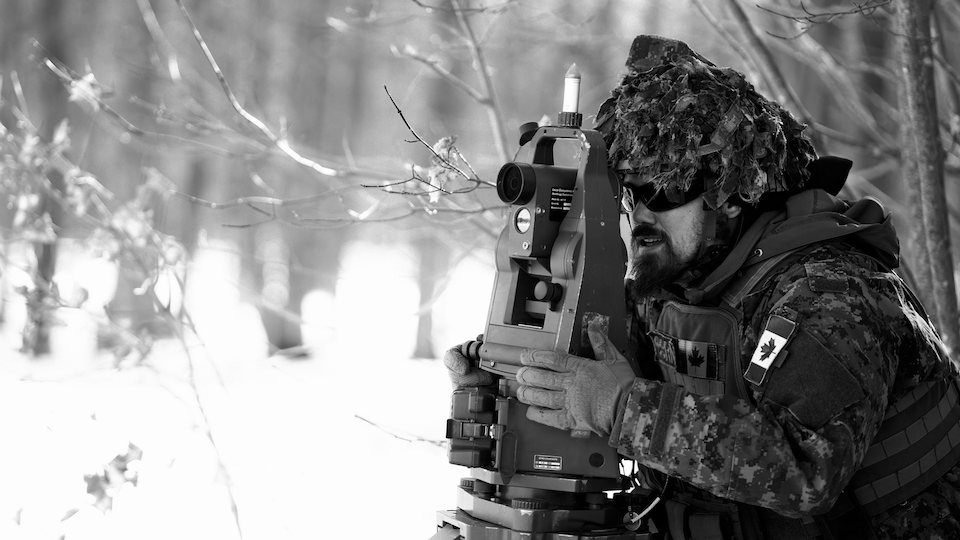
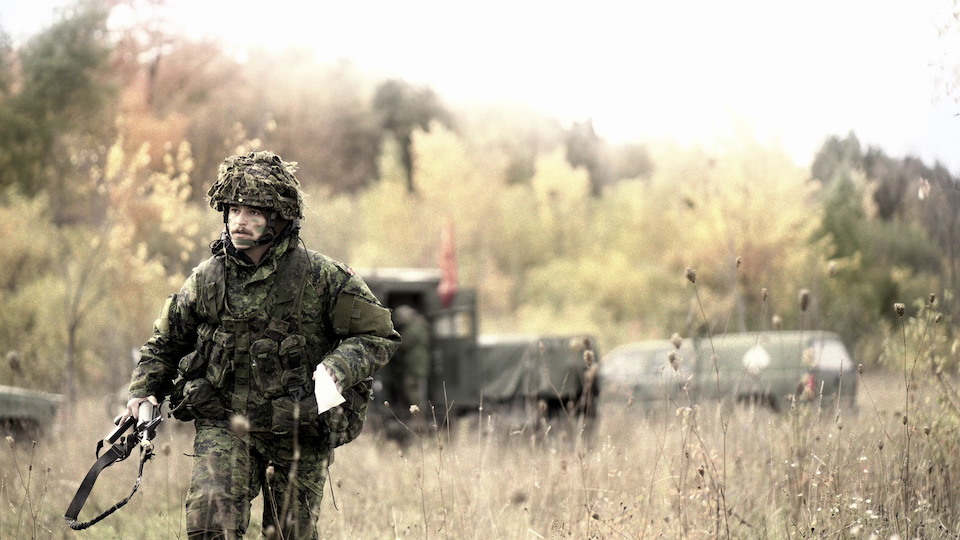

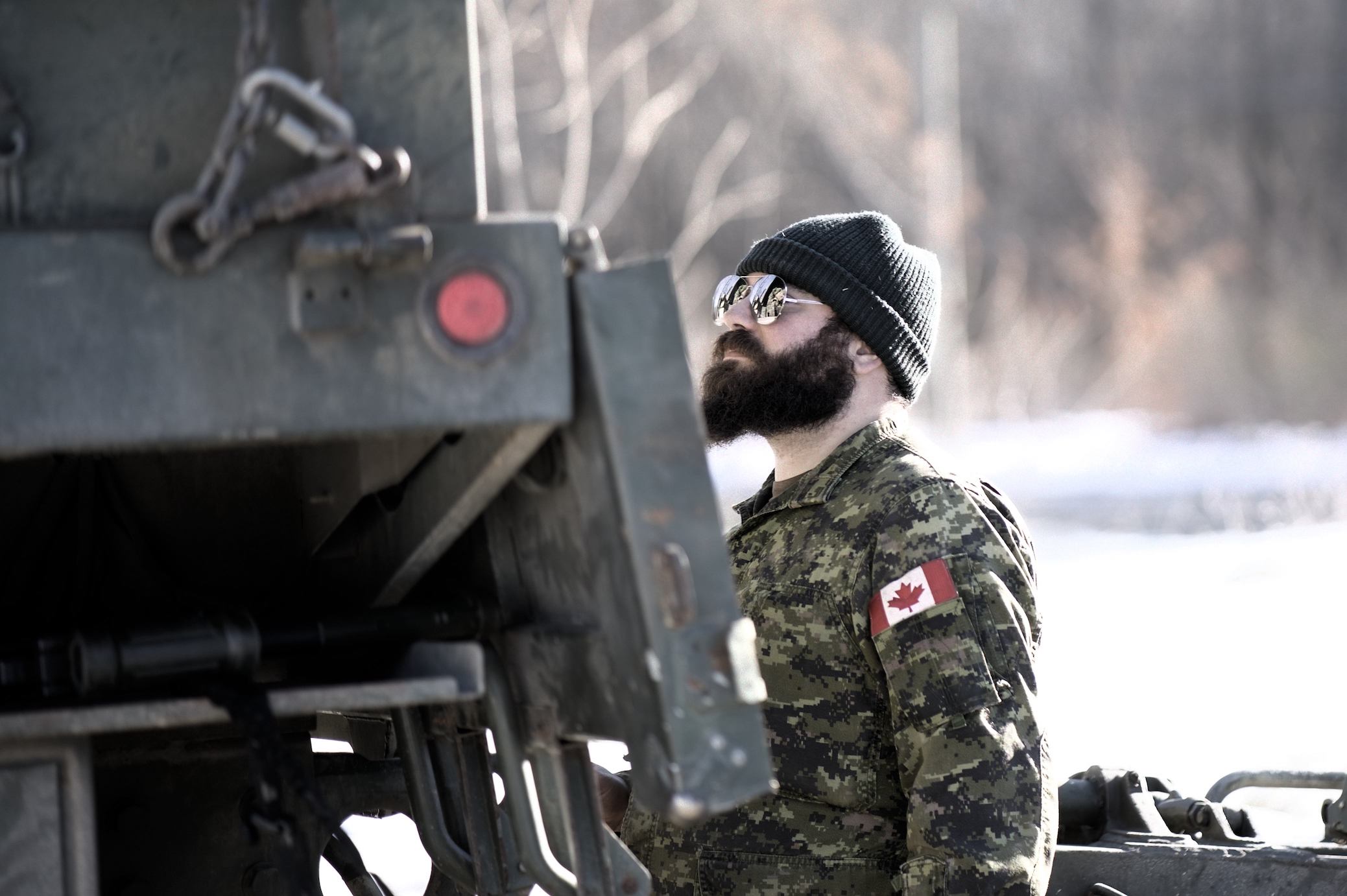
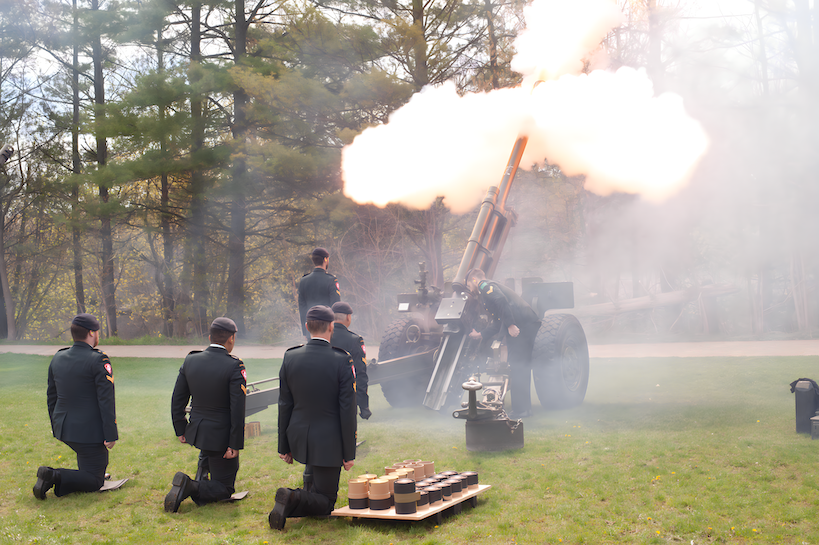
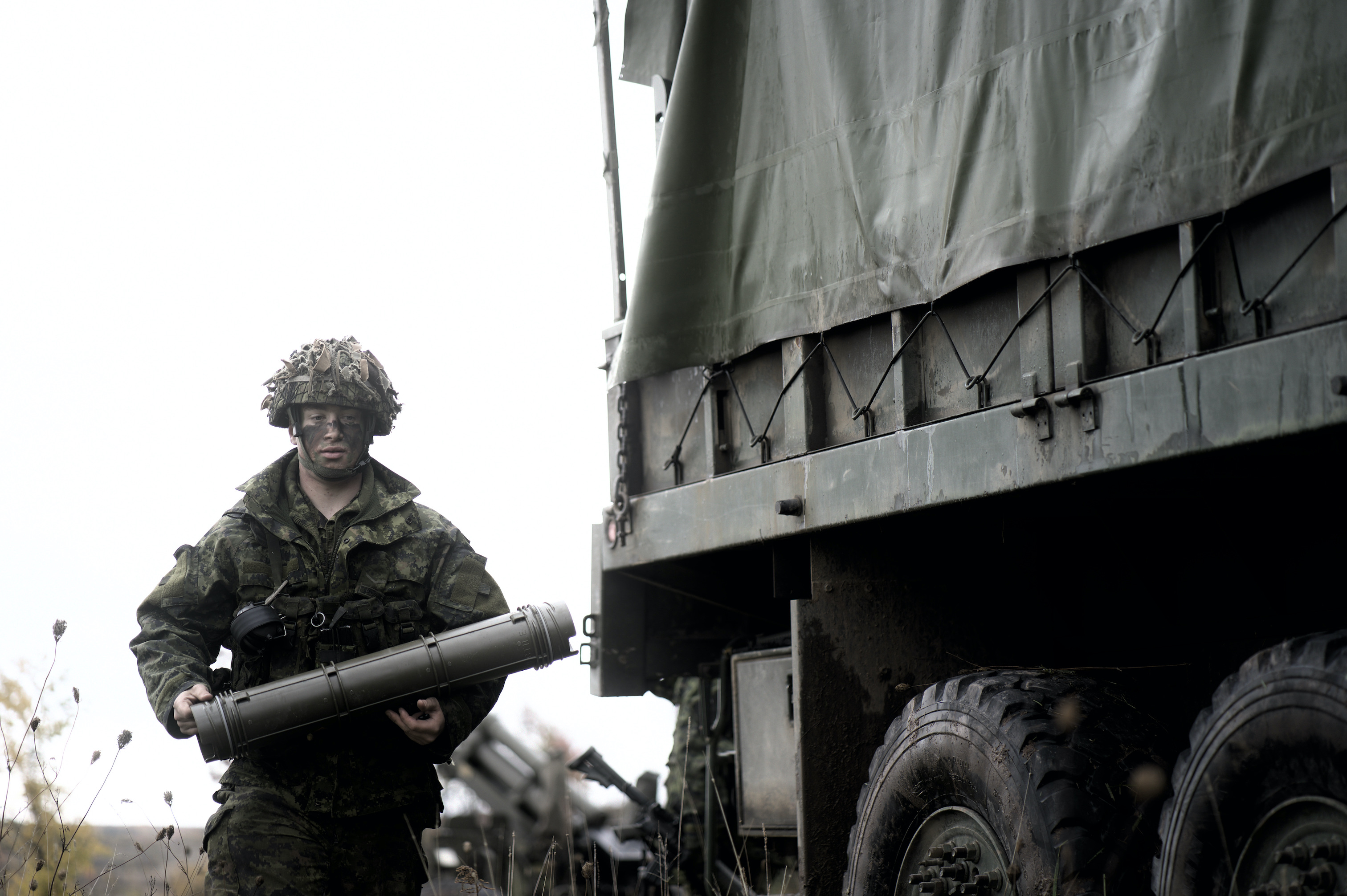
Artillery has been present in Canada from the days of the first colonists. In Wellington County, the 11th Field Artillery Regiment evolved out of the traditional county militia structure. In 1857, all military units in Wellington County were put on a voluntary basis and re-organized as the 1st Wellington Battalion, an infantry organization.
In 1866 the Fenian Brotherhood - a group of expatriate Irishmen in the United States – declared their intent to attack Canada to avenge the English occupation of Ireland. In Wellington County, a militia artillery unit was formed to meet the threat, the first of many units which has given Guelph a reputation as a “Gunner’s Town”.
The first Guelph Artillery unit was created on July 20, 1866, with the founding of the Guelph Battery of Garrison Artillery, which was designed as No. 1 Company of the 30th Wellington Battalion of Rifles. On 7 August 1866, the Battery, commanded by one Captain Barclay, met for their first drill under the direction of Lieutenant Armstrong of the Wellington Rifles. In 1871, the Battery detached from the Battalion and became the Wellington Battery of Artillery. On March 22, 1878, authority was granted to create a second section made up of students from the Ontario Agricultural College (OAC) at Guelph, known as the Ontario Field Battery. The long and valuable association of the college with the militia is commemorated by the aged garrison gun placed outside of the student centre at the University of Guelph. This sad and neglected relic is constantly abused by ignorant vandalism, the periodic painting of which is now a student tradition.
The two Batteries were combined on March 24th, 1880, to create the 1st Provisional Brigade of Field Artillery, with Major A.H. MacDonald, later Mayor of Guelph, as Commanding Officer. The Wellington unit, commanded by Capt W. Nicholl, became No. 1 Field Battery and the O.A.C. unit, commanded by Capt David McCrae, father of John McCrae, author of "In Flanders Fields", became No. 2 Field Battery. The Surgeon was Henry Howitt and the Veterinary Officer was E.A.A. Grange, later Principal of the Ontario Veterinary College. This heralded the formation of Canada's oldest continuous artillery regiment.
The local artillery maintained a high state of efficiency throughout the twilight years of the 19th century and consistently won the major prizes during peacetime training in the Victorian era. Today, the Officer's Mess at the Guelph Armoury boasts a collection of silver trophies that attests to the prowess of the Guelph Gunners.
In 1887, the Batteries were renumbered No. 11 and No. 16. On February 2, 1920, 11 Battery was reorganized and re-designated the 29th Battery Canadian Field Artillery (CFA). It continues today as the 29th Field Battery.
None of the Wellington units were mobilized on the outbreak of the Boer War, instead a separate artillery unit – “D” Battery - was formed. Lt John McCrae commanded a section of the battery, Wellington County's contribution to the force that left for South Africa on January 4th, 1900. The Battery fought in 32 actions including the rearguard action at Leliefontein, where three Victoria Crosses were awarded to soldiers of The Royal Canadian Dragoons while supporting the withdrawal of one of the Left Section’s 12 pounders which was under the command of a future Corps Artillery Commander in WWI, Lieutenant (later Major General Sir) E.W.B. Morrison, who was awarded the Distinguished Service Order for this part in the action.
In 1911, Canada re-organized its militia in response to overseas tensions, seeking to create more cavalry and artillery units. As Guelph had an artillery-equipped unit already, it was allowed to grow and thrive, albeit with antiquated five-inch howitzers. The Brigade was renamed the 1st (Howitzer) Brigade, Canadian Artillery in 1913. When war broke out in 1914, new mobilization plans were devised and names were changed again.
Seven batteries were raised in Guelph during WW I. The entire 16th mobilized under Major W. Simpson with its militia personnel intact. It proceeded to England in May 1915, where it formed part of the 2nd Canadian Divisional Artillery.
New formations were created while many existing units such as the 11th Battery of Guelph sat idle or were disbanded. The new 29th Battery was mobilized in Guelph 1915, with virtually all of its trained members from the old 11th. That same year the 43rd mobilized under the command of Major David McCrae, who was 70 years of age at the time. Much to his no doubt major disappointment, while he commanded the Battery during mobilization, deployment to Britain and during training, he was unable to take his battery to France.
On 26 Feb, 1916, both batteries went overseas to form the 11th (Howitzer) Brigade, CFA. The 55th and 56th Batteries were recruited in Guelph in 1916. Later the 63rd and 64th Batteries were created. The gas attack at Ypres, the battles of the Somme, Passchendaele, Amiens, Arras and Cambrai and Mons mark the road trodden by these gunners, but in no battle did they stand more gloriously than at Vimy Ridge. Artillery batteries from Guelph fought at all the major battles during the static trench warfare of France.
In 1899 a number of gunners from the Wellington Battery, including Lieutenant John McCrae, together with gunners from Ottawa, London and Port Hope joined the newly formed “D” Battery in order to serve in the South African War. In one skirmish, McCrae’s right section silenced the Boer guns near Rustenburg. During his service with “D” Battery, he established a close friendship with Lieutenant (later Major General Sir) E.W.B. Morrison, from Ottawa, who commanded the left section which saw action at the famous battle of Leliefontein in support of the Royal Canadian Dragoons. During the mobilization phase of Canadian Army efforts at the beginning of WWI, Morrison, now a Lieutenant-Colonel and in command of the 1st Brigade C.F.A, asked McCrae to join him as his medical officer; however, in point of fact, originally, he was the Brigade’s Second-in-Command during the formative months in Valcartier, on Salisbury Plain and in action in France. In late April 1915, during the heaviest fighting of the Second Battle of Ypres, McCrae and his dressing station were within sight of the Canadian cemetery. As the fighting continued, when he wasn't performing his Gunner duties in the Brigade's command post, McCrae had his hands full caring for the wounded, and he watched with dismay as the little wooden crosses daily grew more numerous. Wild poppies were already beginning to bloom around the graves. After seventeen exhausting days, and the death of a former student and close friend, Lt Alexis Helmer, he sat down and wrote his immortal poem “In Flanders Fields”, which was published by Punch magazine that December. After Second Ypres, McCrae was ordered to be a full-time Medical Officer and was posted from his first love, the Artillery.
After McCrae’s death from “extensive pneumococcus meninggitis” on 28 January, 1918 while commanding No 3 Canadian General Hospital (McGill) at Boulogne, his friend, and now MGen Morrison, gathered his belongings, including one of the original lead printing plates used by Punch magazine to print his poem. This plate now resides in the Royal Canadian Artillery Museum in Shilo, Manitoba.
As a result of the reorganization of 1920, the 1st Artillery Brigade was re-designated the 11th Brigade CFA. The 16th (Howitzer) Battery became the 16th Battery; the Ammunition Column was re-designated the 11th Brigade Ammunition Column CFA; the 43rd and 63rd Batteries were added to the Brigade and the 13 Siege Battery was attached. The 43rd and 63rd eventually became paper organizations with declining enrolment. In 1925, the brigade was renamed the 11th Field Brigade, Canadian Artillery. This was the largest establishment on record for the Brigade and in March 1935 the Ammunition Column was disbanded. In a piece of fine irony, The Wellington Rifles – from which sprung the first artillery unit in Guelph - were themselves converted to artillery in 1936, a year before their centennial anniversary, to augment the 63rd Battery, leaving artillery as the only military presence in the county.
In 1925, Lieutenant-Colonel George Alexander Drew took command of the Brigade. He had enrolled in 1910 and fought overseas with distinction in the Canadian Field Artillery. After having served as a City Alderman for several years, he was elected as the Mayor of Guelph in 1925. Drew successfully ran for the provincial Conservative Party leadership in 1938 and entered the Legislative Assembly of Ontario through a 1939 by-election as the Member of Provincial Parliament for Simcoe East. In the 1943 provincial election, he was elected in the Toronto riding of High Park. He was Premier of Ontario and Minister of Education from 1943 to 1948. Following his provincial political career, "Colonel Drew" (as he liked to be called) won the 1948 federal Progressive Conservative leadership convention, defeating John Diefenbaker on the first ballot. As leader of the federal Progressive Conservative Party and a Member of Parliament, he became Leader of the Opposition and so served until 1956, being succeeded by John Diefenbaker.From 1957 to 1964, he was the Canadian High Commissioner to the United Kingdom, and in his last post in public life, he was the first Chancellor of the University of Guelph from 1965 to 1971.
At the outbreak of war in 1939, the 29th Field Battery was mobilized and became part of the 3rd Army Field Brigade commanded by LCol C.D. Crowe, MC, who had been a commander of the 29th Battery. The Brigade went overseas in 1940 and shortly afterward had its name changed to the 11th Army Field Regiment at the request of General A.G.L. McNaughton who had commanded the 11th Brigade in the First World War. The 29th Battery remained with the 11th Army Field Regiment (part of 1st Canadian Army Group Royal Artillery [AGRA]) throughout the campaigns in Sicily, Italy and Northwest Europe, where they claim to have been the first Regiment of the 1st Canadian Corps from Italy to be in action on German soil.
The 16th and 43rd Batteries were mobilized together as the 16/43 Battery in May 1940 under command of Major O.M. McConkey, a veteran gunner of the First World War. This Battery was allotted to the 12th Field Regiment but later, as a result of ever-changing artillery doctrine, separated into the two constituent batteries. The 12th Field Regiment, as part of the Divisional Artillery of 3rd Canadian Infantry Division, later provided direct support to the 7th Canadian Infantry Brigade, during the D-Day assault on “Fortress Europe”. On that famous 6th of June 1944, the 16th Battery was commanded by Major J.D. Ross and the 43rd by Major A.G. Goldie.
The 63th Battery was mobilized in the summer of 1941 under command of Major R. Ozburn. It went overseas in July 1943 as part of the 19th Field Regiment (SP) and supported the landings on D-Day of the 3rd Infantry Division using 105mm self-propelled guns (Priests), and later was equipped with 25-pounder SPs (Sextons). As an Army Regiment, and part of 2nd Canadian Army Group Royal Artillery (2nd Cdn AGRA), the work of the Battery was in support of the 2nd and 3rd Infantry Divisions and the 4th Armored Division.
Meanwhile, back in Canada, an Army reorganization in 1942 re-designated the 11th Field Brigade as the 11th Field Regiment, and on April 12th 1960, the present name of the unit, the 11th Field Artillery Regiment, RCA became the official designation.
Artillery presence at the unit level in Hamilton was, prior to 1970, embodied by 8th Field Regiment, first authorized on 1 April 1912 as 13th Brigade, CFA, then as 8th Brigade, CFA on 2 February 1920. Following a series of name changes in the same fashion as 11 Fd Regt over the years, and experiencing its own periods of growth and reduction, 8th Fd Regt (8th Field Brigade) by 1939, consisted of 10 Bty in St Catherines, 11 and 40 Btys in Hamilton and 54 Bty in Brantford. Following WWII, 102 (Wentworth) Bty, previously un-brigaded (independent), was added. More on 8th Fd Regt later.
The 11th Hamilton-Wentworth Field Battery can trace its history to 1836 when a private citizen bought artillery equipment and formed the "Hamilton Cannon Company" manned by civilian volunteers.
In 1854 Britain entered the Crimean War and withdrew all but 3000 troops from North America. To provide for the defense of Canada, the Legislature passed the Militia Act of 1855 to authorize a Militia of 5000 men, including five Batteries of Artillery located in Quebec, Ottawa, Montreal, Hamilton, and Kingston.
The "Militia Field Battery of Hamilton" officially came into being on December 6, 1855. It was renamed the 4th (Hamilton) Field Battery in 1895. Before World War I, one of the Lieutenants of the Battery was H.D.G. Crerar, better known as General Caesar, who would go on to take the battery overseas as its Battery Captain. Crerar would go on to General rank and would command the First Canadian Army in North-West Europe during WWII.
The Battery was mobilized in August 1914 for service in World War 1 and was designated the 7th Field Battery. On 17 Nov 1914 it was again re-designated as the 11th Field Battery and served with the 1st Canadian Division.
Another battery of the 8th Field Regiment was the 40th (Sportman’s) Battery organized during the early days of World War I, and fought with distinction during that campaign. It received its nickname from the numbers of prominent sports personalities associated with it, one of whom was “Connie” Smythe of Maple Leaf fame, who in fact was awarded an MC while a member of 40th Bty in 1917. Conn also served in the Artillery in World War II, this time as an anti-aircraft gunner ultimately as BC of 30th LAA Bty. After he was wounded in Normandy in July of 1944 (at age 49), he was repatriated to Canada and being a hockey celebrity, was wont to talk to the press, which he did, blowing the lid off of the infantry replacement disaster that threatened the very operational effectiveness of II Canadian Corps in North-West Europe. 40th Bty served as a 25 pounder Bty during World War II in 11 Army Field Regiment, along side 29 Bty from Guelph.
The third battery of 8 Field Regiment was 102 Battery from Dundas, which was mobilized as a field battery in early 1941 as a sub-unit of 16 Field Regiment, which was re-rolled to the anti-aircraft branch and re-titled 8th Light Anti-Aircraft Regiment. 102 Battery fought with distinction as part of the 4th Canadian Armoured Division's Artillery from July 1944 to the end of the North-West Europe campaign in May 1945.
Mobilized in June 1940 for service in World War II, 11 Battery proceeded overseas as part of the 12th Field Regiment within the 3rd Canadian Division in July 1941. In July 1943 the 3rd Division began assault training in preparation for the invasion of Europe on June 6th 1944, "D-Day". 11 Battery was the only Hamilton unit to play a role in the landing in Normandy on that day. The Guns of 11 Battery were the first Canadian guns to fire from positions on French soil. Firing in support of the Royal Winnipeg Rifles, the Battery engaged German defensive positions over "open-sights".
During the Normandy campaign, the Battery fired its guns in support of not only the infantry of the 3rd Division but other Divisions such as the 2nd Canadian, 15th Scottish, and Polish Armored. Following the defeat of the German Army in Normandy, the Battery fought its way through Europe to the Rhine River. As part of the 12th Field Regiment the 11th Battery was the first Canadian Artillery deployed across the Rhine.
At the conclusion of the war, the soldiers of the wartime 11 Battery returned home and 11 Battery itself remained part of the 8th Field Regiment together with 40 Battery in Hamilton and 102(Wentworth) Battery in Dundas.
On 25 June 1950, the forces of North Korea invaded South Korea. The situation was dire, as the North Korea Army was able to push South Korea forces as well as the relative handful of US Army forces southward. Seoul, the capital of South Korea, fell on 28 June and by 1 August, the US and South Korean Armies were contained in the area of South Korea known forever after as "The Pusan Perimeter". On 15 September 1950 the famous amphibious landings at Inchon by the American X Corps reversed the situation, beginning the first of a series of offensives and counter-offensives before the front went relatively static in the late summer of 1951.
The Canadian Government's response was surprisingly quick and decisive. On 7 August 1950, The Canadian Army was ordered to expand recruiting practically overnight in order to provide to UN Forces, a Canadian Army Contingent consisting of an entire Infantry Brigade (25 Cdn Inf Bde Gp). Recruiting offices across the country were flooded with volunteers for what was called the Canadian Army Special Force. Volunteers for the CASF signed on for a period of 18 months. From an Artillery perspective, the first unit created for service in South Korea was 2 RCHA, which after a nine month training period, landed in Pusan, South Korea on 4 May 1951.
In May 1951, the Government announced the formation of 27 CIBG for service with NATO in Germany. On 5 May 1951, recruiting for an additional six artillery batteries was authorized. It was originally envisioned that these six batteries would form two Regiments, one of which would be the first to be deployed to Germany, and the other, to replace the first. Focused effort was required, so individual batteries were recruited regionally, centered on existing Reserve Army Regiments. Thus, starting in May 209 (Toronto), 258 (Lévis), 284 (Maritimes), 205 (Montreal), 213 (Winnipeg) and 216 (Guelph) Batteries were created. Army added the prefix number "2" to each in order to differentiate between existing Reserve Batteries and the CASF Batteries; 16 and 216 from 11 Fd Regt as a case in point.
The ranks of 216 Battery were full of not only local recruits from the Guelph area, but also of a large number of members of 11 Fd Regt. Once formed, the complete Battery, along with the other five, went to Shilo Manitoba for basic training. After an initial training period, it was decided to postpone the organization of the second Regiment, so 205, 213 and 216 Batteries were returned to their Home Stations, which for 216 was London, Ontario. While in London, the Battery continued its training programme, conducting its live fire exercises at the Tank Range in Meaford. On 10 April 1952, 81st Fd Regt was authorized to stand up. From May to September of that year, the Regiment's component Batteries (205, 213 and 216) assembled in Wainwright, Alberta for collective training and preparations for deployment to South Korea. From Wainwright, the Regiment moved to Petawawa in September. 81st Fd Regt replaced 1 RCHA in 25 CIBG in Korea in April 1953, eventually becoming 4 RCHA. 216 Bty, having been designated R Bty in Korea, became M Bty on 30 November 1953, as a result of a re-designation of battery letters allocated to each Horse Artillery Regiment.
Arguably the most significant action during 81st Fd Regt's (4 RCHA) tour was in May 1953. During the Chinese attack on Hill 187 on 2-3 May 1953, Lt George Ruffee, Fox Troop Comd (FOO), called down fire of the entire Divisional Artillery on 3 RCR's C Company’s position using VT (proximity) fuses. For this action he was awarded the Military Cross (MC) and his driver, LBdr R.A. Walsh, was mentioned in dispatches. Captain Peter Tees, a Canadian Air OP Officer, was involved in this action and was awarded the Distinguished Flying Cross (DFC).
Also awarded a valour decoration was 216 Bty's Capt Jack De Hart. Between 16 and 29 March 1953, Capt De Hart, seconded to 1 RCHA in advance of 81st Fd's tour of duty due to a FOO casualty, provided "timely and accurate support undoubtedly saved the Royal Netherlanders from being badly mauled by Chinese attacks", for which he was awarded the MC.
Thus it came to pass that a fair share of 11 Fd Regt soldiers found themselves in South Korea for their very busy year long tour of duty with 4 RCHA starting in April 1953; having fired 120,000 rounds of 25 pounder ammo in stalwart support of the 3rd Battalions of The RCR, The PPCLI and The R22eR.
1970 was a significant year for the Regiment. Additional army reorganization called for the transfer to the supplementary order of battle of the 8th Field Artillery Regiment of Hamilton along with its 40 and 102 Batteries. As one can imagine, this traumatic event was bitterly contested and a compromise of sorts was reached with the decision to have 11 Field Battery remain active, but transferred under the command of the 11th Field Artillery Regiment. At the same time approval was granted for restoration of 11 Battery's Historical name "Hamilton" and for preservation of 102 Battery's "Wentworth" designation. Interestingly, 11 Battery was no stranger, as it was one of the three sub-units that made up the wartime-only 12th Field Regiment, the other two being the 16th and the 43rd, both from 11 Field in Guelph. And so with the surviving battery of 8th Field, 11 Field Battery, under its command, the 11th Field Artillery Regiment is proud to perpetuate the traditions of its sister Regiment.
The late 1950’s saw the retirement of the 25 pounder gun and its replacement with the 105mm C1 Howitzer. Following the Cuban Missile Crisis of October 1962, and in anticipation of nuclear holocaust in the era of Mutually Assured Destruction (MAD), the Regiment’s primary focus was that of civil defense with very little gunnery training taking place. During this period, it was envisioned by NDHQ that the Primary Reserve's main focus should be the assistance to the civil authorities in the event of a nuclear war. The situation had improved by the mid 1960s when gunnery training once again became the Regiments primary occupation. A highlight of that period was the training support provided by 2 Arty Training Regiment out of Borden which resulted in the return of Artillery skills within the Regiment after the bizarre period of what was irreverently known as Snakes and Ladders (Civil Defense).
The regiment celebrated its Centennial in 1966 with a Vice-Regal visit to Guelph from Governor-General and Mme. Vanier, and a jet fly-past by the Royal Canadian Air Force in T-33 aircraft. The regiment was given the Freedom of the City, and the Fenian Brotherhood of Buffalo, New York, attended to apologized for the Fenian Raids of 1866.
The long years of a dearth of direct operational experience during the 60s, 70s and 80s were marked with many an exercise and event in the life of the Regiment in the familiar locales of Meaford, Petawawa, Borden, home garrisons and all points in between and afar. Honorable mention must go to the thousands of soldiers who served in Guelph and Hamilton in the 60s, 70s and 80s and who kept the flame of the profession alive, who trained hard and with dedication with the spectre of World War III with the Soviet Union and its Warsaw Pact allies just around the corner and who passed their knowledge and the traditions of the Regiment on to following generations. This passage of the torch from one generation to the next bore fruit during the conflict-filled decades of the next 20 years.
Prior to 1991, who could have foreseen the path that the Canadian Army was to follow. The never-ending cycle of what at times seemed like training for the sake of training, was forever broken by the call for volunteers for such places as Croatia, Bosnia, Kosovo and Afghanistan. A number of Regimental personnel served as part of Canada's last full contingent to the UN forces in Cyprus in 1993.
Others have served in the Former Republic of Yugoslavia, including two Junior NCOs with the guns of F Battery in 2001 and a Warrant Officer as a member of the CIMIC organization. Personnel have also served in UN missions to the Golan Heights, Cambodia and Sierra Leone. Maintaining a long affiliation with 2nd Regiment Royal Canadian Horse Artillery, members of the Regiment continued to volunteer and augment D, E and F Batteries deploying to Afghanistan during multiple deployments during the period 2006 to 2010. In fact, at least 44 members of the Regiment have served in Afghanistan in one capacity or another. 11 Field soldiers have been employed on the gun lines in the Forward Operating Bases, Patrol Bases and outside the wire throughout the Canadian Area of Operations in the Province of Kandahar and beyond in support of the Canadian Battle Group and OMLT, the British Task Force and American Special Forces units. They have served as members of FOO parties in direct support of their infantry in some of the hottest (pun intended) parts of the Province. Others have served as staff officers in HQ Task Force Kandahar or HQ Regional Command South at Kandahar Airfield; and still others as members of the Close Protection capability in Kabul and Kandahar, in CIMIC and the OMLT.
Domestically, members of the Regiment deployed to flood ravaged Southern Manitoba in 1997. Half of the Regiment's effective strength of dedicated part-time soldiers deployed to ice stricken Eastern Ontario during the 1998 Ice Storm and personnel deployed to 8 Wing Trenton to support the Kosovo Refugee Crisis in 1999. The Regiment has also had the opportunity to co-operate with local and provincial police in the search for missing persons and continues to deploy persons on Northern sovereignty operations.
The Regiment remains socially active in Hamilton and Guelph. Some activities included hosting charity events such as the United Way Campaign Kick-off BBQ for Guelph and Wellington County and the Canadian Breast Cancer Foundation, Run for the Cure in 2004 and 2005. In Hamilton, the Regiment has sponsored the Bell Walk for Kids Help Phone.
As part of Military District Number Two prior to the early 1970’s, as part of Hamilton Militia District following restructure and now as part of 31 Canadian Brigade Group since 1995, 11th Field Artillery Regiment continues its tradition of faithful and dedicated service to Canada. As it has for 159 years in Hamilton and 148 years in Guelph, in one form or another, the 11th Field Artillery Regiment, with the proud traditions and memories of its predecessors in peace and war as its foundational bedrock, continues to serve Canada in keeping with the mottos of the Royal Regiment of Canadian Artillery:
UBIQUE
Quo fas et gloria ducunt.
"Everywhere. Whither right and glory lead."






Website hosting and services generously provided by the Artillery Support Group.
29th Field Battery | 11th Field Regiment, RCA | 7 Wyndham Street South Guelph, Ontario N1H 4C4 Office : (519) 824-0351 x3244
11th Field Battery | 11th Field Regiment, RCA | 200 James St. North Hamilton, Ontario L8R 2L1 Office : (905) 972-4000 x4005